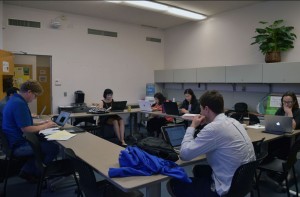
Members of the University Grants Academy meet for a work session as a deadline approaches in their grant process. The inaugural academy provided support to two cohorts of faculty members.
Professors Amy D’Andrade and John Lee will again be leading the San Jose State University Grants Academy (UGA) program, with two informational sessions planned for September for tenured/tenure track faculty members who are interested in applying to participate this year.
Of the 2015-16 participants, 20 participants had completed a full proposal by the end of the program and as of the end of July, ten UGA participants had submitted proposals to the National Science Foundation, the National Institutes of Health and other private funders for a combined total of nearly $4 million. Others have upcoming submission deadlines for proposals.
“In addition to these concrete outcomes, each of the UGA participants learned how to access the campus units and partners who will support them through the process of grant writing and grant submission, and made connections with successful SJSU grant writers who served as mentors,” D’Andrade said.
Two Informational Sessions: Thursday, Sept. 8, from noon to 1 p.m. via WebEx (email amy.dandrade@sjsu.edu for an invitation) and Friday, Sept. 9, from 2:30 to 3:30 p.m., in IRC 210
Contact Info: Professor Amy D’Andrade, UGA Director, amy.dandrade@sjsu.edu
Website Link: http://www.sjsu.edu/research/funding/funding-opportunities/uga/
“Participants became more adept at all the major steps involved with writing an external grant proposal,” said D’Andrade, a social work professor and associate dean for research in the College of Applied Sciences and Arts. “After the UGA, participants reported feeling much more capable of locating a funder, drafting a budget and writing a strong proposal narrative for an external grant.”
The UGA launched in fall 2015 as an opportunity for faculty members to gain advice and insight on applying for external grants to support their research. Candidates who were selected had a viable project and were ready to apply for external funding. In addition to assigned time of 0.2, the program included informational sessions held in the fall, with representatives from the Office of Research, Research Foundation, University Advancement and the Center for Faculty Development. In addition, the 24 faculty participants received mentoring from SJSU faculty members who successfully received external grant funding, and received multiple reviews of their proposal drafts from UGA peers, campus experts, mentors and senior scholars from outside the university.
“The inaugural participants contributed several constructive ideas on how the program can be made even better,” said Lee, a professor of mechanical engineering in the Charles. W. Davidson College of Engineering. “They had suggestions on modifying the structure, sizing and sequencing of activities so that feedback could be used more interactively and constructively. I really look forward to benefitting from their suggestions in the next go-around.
First-year participant Child and Adolescent Development Associate Professor Nadia Sorkhabi, from the Connie L. Lurie College of Education, had a strong publication record and had largely been conducting research using intramural grants, which she believed provided her with an empirical basis to apply for external funding.
“By attending the talks and workshops, and consulting individually with Dr. Amy D’Andrade, Dr. Gilles Muller, Dr. Pamela Stacks and others, the most daunting aspects of grant writing – such as budget – were made manageable and even simple,” Sorkhabi said. “We also received invaluable emotional and motivational support, and encouragement, which I believe is among the most important impediments in undertaking grant writing.”
Professor Cay Horstmann, who teaches computer science in the College of Science, said he applied to participate in the UGA to get support in applying for external funding. While he has been at SJSU for many years during which he has been actively involved in publishing books and conducting research with graduate students, he had been unaware that the National Science Foundation (NSF) is now providing significant funding to universities whose primary mission is teaching
“I didn’t know that, and there is definitely money available for computer science education,” he said.
One of the key things Horstmann appreciated about the UGA was the opportunity to learn about other research interests on campus.
“It puts us together with other people – otherwise you are a lone player,” he said, noting that he met a colleague who is working with an NSF grant on math education and that they may be able to collaborate in the future.
D’Andrade said she appreciated the chance to get to know other faculty on campus, but also to see their work come together.
“In addition to having the opportunity to become acquainted with a great group of creative and determined faculty, it was wonderful to see all the proposals come together over the semester, piece by piece, and to see the list of all proposal titles at our final celebration,” D’Andrade said.